Caryn’s Thoughts

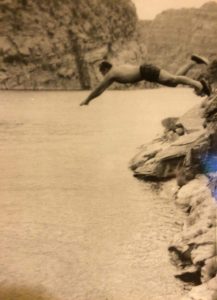 My uncle, Elmer Johnson worked a number of places, mostly as a truck driver of one type or another. He moved furniture for Burke Moving and Storage and for United Van Lines, working for Tom Aurelius, and often taking his oldest son, Elmer along with him for a couple of weeks in the summertime. When his son, Elmer was older, they had the opportunity to work together at Dalgarno Transportation. Uncle Elmer was also a certified welder working on pipeline, and later worked in the Uranium mines at Shirley Basin. While Uncle Elmer worked hard to support his family, his job was never where his heart was. His heart was with his family, and showing them the great outdoors.
My uncle, Elmer Johnson worked a number of places, mostly as a truck driver of one type or another. He moved furniture for Burke Moving and Storage and for United Van Lines, working for Tom Aurelius, and often taking his oldest son, Elmer along with him for a couple of weeks in the summertime. When his son, Elmer was older, they had the opportunity to work together at Dalgarno Transportation. Uncle Elmer was also a certified welder working on pipeline, and later worked in the Uranium mines at Shirley Basin. While Uncle Elmer worked hard to support his family, his job was never where his heart was. His heart was with his family, and showing them the great outdoors.
Uncle Elmer was raised loving the outdoors, and fishing was always a family fun time. Time spent at the lake, swimming, or just clowning around with his brothers was the way to have fun in the summer. For my cousin, Elmer, those are the times he remembers as the very best part of life. Camping, fishing the most of the lakes and quite a few of the creeks throughout the state of Wyoming. They camped out and rented cabins in places like Louis Lake and Meadowlark Lake. Elmer remembers that his dad was always happiest with a fishing pole in one hand and a beer in the other. It’s no wonder that Elmer has a boat and spends as much time at the lake as he can, often taking his niece, JeanAnn and her kids, Mykenzie and Ethan along so he can show them the great times he had as a kid.
Since Uncle Elmer passed away in 1981, when my cousin, Elmer was just 25 years old, those great family times 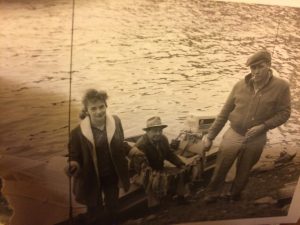
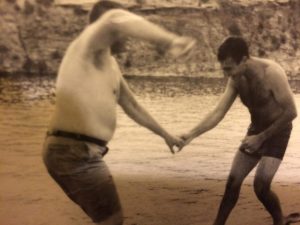 have become more and more precious. His mom, Deloris Johnson’s passing in 1996 made that family time even more precious. Elmer has worked very hard to keep his dad’s dream lifestyle alive. In many ways, Elmer is carrying on his dad’s legacy, and I know that Uncle Elmer would be very pleased and very proud of Elmer. Today would have been Uncle Elmer’s 86th birthday. Happy birthday in Heaven Uncle Elmer. We love and miss you very much.
have become more and more precious. His mom, Deloris Johnson’s passing in 1996 made that family time even more precious. Elmer has worked very hard to keep his dad’s dream lifestyle alive. In many ways, Elmer is carrying on his dad’s legacy, and I know that Uncle Elmer would be very pleased and very proud of Elmer. Today would have been Uncle Elmer’s 86th birthday. Happy birthday in Heaven Uncle Elmer. We love and miss you very much.
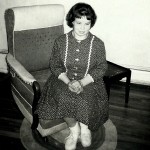
 I have four sisters, and three brothers-in-law. My husband Bob had four sisters and one brother. He still has three sisters, his brother, a sister-in-law, and two brothers-in-law. We are missing his sister, Marlyce, who died of cancer on August 13, 1989 at just 39 years old. Marlyce was the first sibling death any of us had experienced, and it left a large hole in our lives. It just seemed impossible, like a horrible nightmare. How could our sweet Marlyce be gone? I suppose that disbelief at her passing, showed the innocence we all had about life, even though we weren’t seriously young. There are just people you don’t expect to lose…at least not until much later in life, and siblings definitely fall into that category. When Marlyce passed away, she took with her a portion of the joy the family had always had. She was always so sweet, and filled with a desire to help others, and make people happy.
I have four sisters, and three brothers-in-law. My husband Bob had four sisters and one brother. He still has three sisters, his brother, a sister-in-law, and two brothers-in-law. We are missing his sister, Marlyce, who died of cancer on August 13, 1989 at just 39 years old. Marlyce was the first sibling death any of us had experienced, and it left a large hole in our lives. It just seemed impossible, like a horrible nightmare. How could our sweet Marlyce be gone? I suppose that disbelief at her passing, showed the innocence we all had about life, even though we weren’t seriously young. There are just people you don’t expect to lose…at least not until much later in life, and siblings definitely fall into that category. When Marlyce passed away, she took with her a portion of the joy the family had always had. She was always so sweet, and filled with a desire to help others, and make people happy.
One of the greatest events in Marlyce’s life was the day she became an aunt. She always loved babies, and each new niece or nephew was a treasure. Of all the nieces and nephews, there was only one she did not get to meet, Eric Parmely. And of course, she never got to meet all the grand nieces and grand nephews, or her great grand niece…sadly, because she would have loved every one of them. Marlyce’s developmental disabilities didn’t keep her from being able to hold the babies, and play with the little ones. She loved them as if they were her own babies. I suppose that if her circumstances had been different, maybe she could have been a mom, but that was not to be.
Marlyce went to Wood’s School as a child. Wood’s was a school for the developmentally disabled back then. These days the school district tries to incorporate these students into the public school system. I like that, whenever it is possible, but Marlyce had a great education anyway, and then they helped her to find a job. Marlyce worked several places, and always liked going to work. She never wanted to miss work…not for illness, 
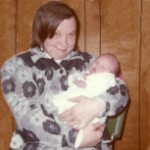 holidays, or vacations…except maybe Christmas. Marlyce loved being needed. Baking cookies, holding babies, working, and knitting were things that made her feel useful. What she never knew was that she was so much more than those things to us. We would have loved her even if she couldn’t make things, work, or even hold the babies. Marlyce holds a special place in our hearts, and she always will. Today would have been Marlyce’s 69th birthday. I can’t believe that she has been gone almost 30 years now, but I miss her like it was yesterday. Happy birthday in Heaven, Marlyce. We love and miss you.
holidays, or vacations…except maybe Christmas. Marlyce loved being needed. Baking cookies, holding babies, working, and knitting were things that made her feel useful. What she never knew was that she was so much more than those things to us. We would have loved her even if she couldn’t make things, work, or even hold the babies. Marlyce holds a special place in our hearts, and she always will. Today would have been Marlyce’s 69th birthday. I can’t believe that she has been gone almost 30 years now, but I miss her like it was yesterday. Happy birthday in Heaven, Marlyce. We love and miss you.
 After his mother, Ramona Hadlock passed away, my brother-in-law, Chris Hadlock and my sister, Allyn Hadlock inherited his parents’ place on the North Platte River east of Casper. Chris always loved his childhood home, and he can’t wait to move back there. Chris’ parents bought their place in 1973, put a mobile home on the land, and the rest is history…family history, that is. For the most part, Chris and his younger brother, Doug were the children still at home. They loved country living. In the winter, the river and the creek on their property froze, and while they didn’t ride bicycles on the river, they did on the frozen creek. They also took turns pulling each other behind a bicycle on the frozen creek. Chris often talks about his life there and his thoughts are filled with the Christmas barbecues and summertime picnics in the back yard which sits right on the river. Those were happy days when both his parents were still alive, and the time he spent learning things from them.
After his mother, Ramona Hadlock passed away, my brother-in-law, Chris Hadlock and my sister, Allyn Hadlock inherited his parents’ place on the North Platte River east of Casper. Chris always loved his childhood home, and he can’t wait to move back there. Chris’ parents bought their place in 1973, put a mobile home on the land, and the rest is history…family history, that is. For the most part, Chris and his younger brother, Doug were the children still at home. They loved country living. In the winter, the river and the creek on their property froze, and while they didn’t ride bicycles on the river, they did on the frozen creek. They also took turns pulling each other behind a bicycle on the frozen creek. Chris often talks about his life there and his thoughts are filled with the Christmas barbecues and summertime picnics in the back yard which sits right on the river. Those were happy days when both his parents were still alive, and the time he spent learning things from them.
Chris and Allyn have been busily tearing out anything useful in the old mobile home that his parents lived  in, because they plan to sell their home in Casper to their son, Ryan and daughter-in-law, Chelsea and their family. With the proceeds of the sale, they will build their new home on the river, in the place they love to be. It was in this back yard that their rehearsal dinner was held the night before their wedding…37 years ago. And this is the land where so many other family gatherings have been held. It’s no wonder it holds such a big place in Chris’ heart. I’m sure that when he is there, he can almost visualize his parents all around him. I know that because it is the way I feel when I am in my parents home, which is now where my sister, Cheryl Masterson lives. Being able to go back to your childhood home is such a blessing, and I know that is how Chris feels too. The tearing down of the house was something they could not bear to watch in person, because it was Chris’ childhood home, and it felt so final to tear it down, but now that it is gone, they have been able to move forward with the plans for the new house, the construction of which is scheduled to begin soon.
in, because they plan to sell their home in Casper to their son, Ryan and daughter-in-law, Chelsea and their family. With the proceeds of the sale, they will build their new home on the river, in the place they love to be. It was in this back yard that their rehearsal dinner was held the night before their wedding…37 years ago. And this is the land where so many other family gatherings have been held. It’s no wonder it holds such a big place in Chris’ heart. I’m sure that when he is there, he can almost visualize his parents all around him. I know that because it is the way I feel when I am in my parents home, which is now where my sister, Cheryl Masterson lives. Being able to go back to your childhood home is such a blessing, and I know that is how Chris feels too. The tearing down of the house was something they could not bear to watch in person, because it was Chris’ childhood home, and it felt so final to tear it down, but now that it is gone, they have been able to move forward with the plans for the new house, the construction of which is scheduled to begin soon.
These days Chris talks about the new memories they will make at his childhood home, because while the  house is gone, and a new one will soon take it’s place, and his parents’ echo still remains all over the land. That will always be with him. He plans to continue many of the traditions of his parents, and of course they will start many new traditions with their own family, and with the families of their combined siblings too. The place is beautiful and quite big, so it can accommodate lots of people, and at the back fence, you can sit and view the lazy river going by. There are wild turkeys and lots of other birds, and of course, the fresh air and wide open spaces. I know that as Chris and Allyn live on the land, it will grow into a wonderful place where they will want to spend the rest of their lives…other than their place on the mountain, of course. Today is Chris’ birthday. Happy birthday Chris!! Have a great day!! We love you!!
house is gone, and a new one will soon take it’s place, and his parents’ echo still remains all over the land. That will always be with him. He plans to continue many of the traditions of his parents, and of course they will start many new traditions with their own family, and with the families of their combined siblings too. The place is beautiful and quite big, so it can accommodate lots of people, and at the back fence, you can sit and view the lazy river going by. There are wild turkeys and lots of other birds, and of course, the fresh air and wide open spaces. I know that as Chris and Allyn live on the land, it will grow into a wonderful place where they will want to spend the rest of their lives…other than their place on the mountain, of course. Today is Chris’ birthday. Happy birthday Chris!! Have a great day!! We love you!!
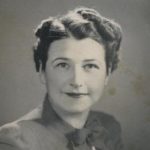 There have been many inventions that were discovered by accident, but none was sweeter than the Chocolate Chip Cookie. My sister-in-law, Marlyce Schulenberg loved to make cookies, and she knew that I was partial to her chocolate chip cookies, but she didn’t invent them. We have to thank Ruth Graves Wakefield for that. It was one of apparently several “mistakes” Ruth made in the kitchen. We’ve all been there, but this mistake was not disastrous.
There have been many inventions that were discovered by accident, but none was sweeter than the Chocolate Chip Cookie. My sister-in-law, Marlyce Schulenberg loved to make cookies, and she knew that I was partial to her chocolate chip cookies, but she didn’t invent them. We have to thank Ruth Graves Wakefield for that. It was one of apparently several “mistakes” Ruth made in the kitchen. We’ve all been there, but this mistake was not disastrous.
Ruth and her husband, Kenneth owned Toll House Inn in Whitman, Massachusetts. Ruth prepared the recipes and cooked for the inn’s guests. One day in 1930, she had a problem. She was out of baker’s chocolate for her scrumptious Butter Drop Do cookies. She knew that her guests always looked forward to those cookies and would be upset if  she didn’t have any. She gave the matter some thought, and decided that she could just break up a bar of Nestle’s semisweet chocolate into tiny chunks and mixed them into the batter. She assumed that the chocolate would melt, spread into the dough as it baked, and create a chocolate-flavored cookie. Unfortunately, chocolate is a little be more resilient than that. The chunks melted…to a degree, but pretty much held their position in the cookie dough. When she took the cookies out of the oven, she noticed that the chocolate chunks only melted slightly, holding their shape and forming a creamy texture. It was too late to do anything else, so she served the cookies to her guests, who absolutely loved them.
she didn’t have any. She gave the matter some thought, and decided that she could just break up a bar of Nestle’s semisweet chocolate into tiny chunks and mixed them into the batter. She assumed that the chocolate would melt, spread into the dough as it baked, and create a chocolate-flavored cookie. Unfortunately, chocolate is a little be more resilient than that. The chunks melted…to a degree, but pretty much held their position in the cookie dough. When she took the cookies out of the oven, she noticed that the chocolate chunks only melted slightly, holding their shape and forming a creamy texture. It was too late to do anything else, so she served the cookies to her guests, who absolutely loved them.

Ruth’s chocolate chip cookies began attracting people from all over New England. After her recipe appeared in a Boston newspaper, Nestle gained a huge spike in sales. Everyone wanted Nestle’s semisweet chocolate bars to make Ruth Wakefield’s cookies. Andrew Nestle came up with a great marketing idea that would be beneficial for both of them. Nestle agreed to give Wakefield a lifetime supply of the chocolate in return for her recipe printed on every Nestle semisweet chocolate bar. Later, of course, they printed it on the bags of chocolate chips, because who wants to break up all that chocolate, when it could be done for you and placed in a bag. I don’t know of anyone who hasn’t had chocolate chip cookies in their lifetime, and we can all thank Ruth Wakefield and her cookie mistake for that scrumptious treat.
 When Audrianna “Anna” Masterson was born, her mom, Dustie Masterson, knew that the baby girl completed their family. Now, 12 years later, her mom says that Anna’s very presence makes her smile. Anna loves cheesy jokes as much as her mom, so they laugh and joke off of each other a lot. Still, those 12 years weren’t all carefree and easy…just mostly. Once, when Anna was just three years old, she gave her parents quite a scare. They were freaking out because she had buried herself in a pile of clothes and fallen asleep. Anna slept so soundly, that she did not hear her family yelling and screaming her name. Still, if that is the worst thing Anna ever does, I’d say she’s a keeper. Her parents, Rob and Dustie are finding it really hard to believe Anna is
When Audrianna “Anna” Masterson was born, her mom, Dustie Masterson, knew that the baby girl completed their family. Now, 12 years later, her mom says that Anna’s very presence makes her smile. Anna loves cheesy jokes as much as her mom, so they laugh and joke off of each other a lot. Still, those 12 years weren’t all carefree and easy…just mostly. Once, when Anna was just three years old, she gave her parents quite a scare. They were freaking out because she had buried herself in a pile of clothes and fallen asleep. Anna slept so soundly, that she did not hear her family yelling and screaming her name. Still, if that is the worst thing Anna ever does, I’d say she’s a keeper. Her parents, Rob and Dustie are finding it really hard to believe Anna is  turning 12 this year.
turning 12 this year.
Anna is very into Anime…which is hand-drawn and computer animation game out of Japan. I’m told that her sister, Raelynn can be held responsible for this. Apparently, she doesn’t love board games…or so she says, but when the family sits down to play, she has a blast. The same applies to bowling. The latest thing these days is Comic-Con, and Casper is holding their very first Comic-Con. Raelynn and Anna are going this weekend. Anna graduated from elementary school this year and her graduation gift was a ticket to go to Comic-Con with her best friend Julie. She was also invited to go with a close friend of the family and his daughter who is a  good friend of Anna’s too.
good friend of Anna’s too.
Anna loves to read, and can often be found reading on her phone. I can relate to that. There is a whole world of stories and information out there. All we have to do is pick up a book, or even our phone. Anna is a very soft hearted girl, and she depends on her siblings, with whom she is very close, whenever she is upset…which isn’t really very often, but she counts on them when she is. She looks to both of them and will call them on the phone, if they are not home. While she depends on her siblings, Anna really enjoys having her own room for the first time ever. As she grows up, she is finding out that having your own space is really cool too. Today is Anna’s 12th birthday. Happy birthday Anna!! Have a great day!! We love you!!
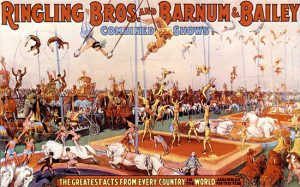 Most people have attended a circus at one time or another, although they are becoming a little more something from the past. Nevertheless, they used to be huge attractions, and when the circus came to town, almost the whole town turned out to watch the show. That was something that worked against the people of Hartford, Connecticut on July 6, 1944. At that time, Hartford was a city of approximately 13,000 people. The Independence Day festivities had just passed and now the circus was in town to continue the week’s excitement for the townspeople. The Ringling Brothers and Barnum Baily Circus was famous for its incredible show, held under a huge circus tent. At 8,000 people in attendance, about 2/3 of the town was there. It was going to be a great show, and the children of the town were beyond excited.
Most people have attended a circus at one time or another, although they are becoming a little more something from the past. Nevertheless, they used to be huge attractions, and when the circus came to town, almost the whole town turned out to watch the show. That was something that worked against the people of Hartford, Connecticut on July 6, 1944. At that time, Hartford was a city of approximately 13,000 people. The Independence Day festivities had just passed and now the circus was in town to continue the week’s excitement for the townspeople. The Ringling Brothers and Barnum Baily Circus was famous for its incredible show, held under a huge circus tent. At 8,000 people in attendance, about 2/3 of the town was there. It was going to be a great show, and the children of the town were beyond excited.
With the tent filled to capacity, a fire is the worst nightmare, but that is what they had. No one knows exactly what happened, and the 8,000 people inside really had no time in which to react. As panic spread as fact as the fire broke out under the big top of circus, killing 167 people and injuring 682. Two thirds of those who perished 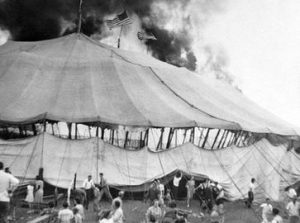 were children. The cause of the fire was unknown, but it spread at incredible speed, racing up the canvas of the circus tent. Suddenly, patches of burning canvas began falling on them from above, and a stampede for the exits began. People became trapped under fallen canvas, but most were able to rip through it and escape, but after the tent’s ropes burned and its poles gave way, the whole burning big top came crashing down, trapping those who remained inside. Within 10 minutes it was over, and some 100 children and 60 of their adult escorts were dead or dying.
were children. The cause of the fire was unknown, but it spread at incredible speed, racing up the canvas of the circus tent. Suddenly, patches of burning canvas began falling on them from above, and a stampede for the exits began. People became trapped under fallen canvas, but most were able to rip through it and escape, but after the tent’s ropes burned and its poles gave way, the whole burning big top came crashing down, trapping those who remained inside. Within 10 minutes it was over, and some 100 children and 60 of their adult escorts were dead or dying.
The fire investigation revealed that the tent had undergone a treatment with flammable paraffin thinned with three parts of gasoline to make it waterproof. These days, no on would consider using gasoline for such a purpose, but unfortunately at that time it was used. Ringling Brothers and Barnum and Bailey Circus eventually agreed to pay $5 million in compensation, and several of the organizers were convicted on manslaughter charges. In 1950, the cause was finally uncovered in the case when Robert D Segee of Circleville, Ohio, confessed to starting the Hartford circus fire. Segee claimed that he had been an arsonist since the age of six and that “an apparition of an Indian on a 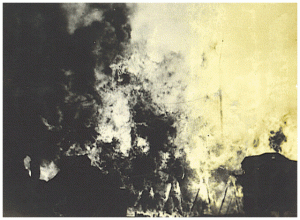 flaming horse often visited him and urged him to set fires.” In November 1950, Segee was convicted in Ohio of unrelated arson charges and sentenced to 44 years of prison time. The Hartford investigators raised doubts over his confession. Segee had a history of mental illness, and it could not be proven he was anywhere within the state of Connecticut when the fire occurred. Connecticut officials were also not allowed to question Segee, even though his alleged crime had occurred in their state. Segee, who died in 1997, denied setting the fire as late as 1994 during an interview. Because of this, many investigators, historians, and victims believe the true arsonist…if it was indeed arson…was never found.
flaming horse often visited him and urged him to set fires.” In November 1950, Segee was convicted in Ohio of unrelated arson charges and sentenced to 44 years of prison time. The Hartford investigators raised doubts over his confession. Segee had a history of mental illness, and it could not be proven he was anywhere within the state of Connecticut when the fire occurred. Connecticut officials were also not allowed to question Segee, even though his alleged crime had occurred in their state. Segee, who died in 1997, denied setting the fire as late as 1994 during an interview. Because of this, many investigators, historians, and victims believe the true arsonist…if it was indeed arson…was never found.

 We have all made plans for the future we wanted to have, and truly, expected to have, only to have something happen that changed everything. Our plans as kids and young people are often the first plans to change, as we grow up and decide our plans were just not for us. Then, we decide that we want a whole new life plan. Still, sometimes, it isn’t something tragic or amazing, but rather just something that changes the way we see things…changes our priorities.
We have all made plans for the future we wanted to have, and truly, expected to have, only to have something happen that changed everything. Our plans as kids and young people are often the first plans to change, as we grow up and decide our plans were just not for us. Then, we decide that we want a whole new life plan. Still, sometimes, it isn’t something tragic or amazing, but rather just something that changes the way we see things…changes our priorities.
As a girl I wanted to be a school teacher…of high school, no less. These days I can’t imagine teaching high school, but I still have a knack for teaching people things. I think I would prefer adult students, and technology as a subject…if I were going to teach, but then I don’t have all the necessary training for that field either. After having a family and raising our girls to junior high, I went back to work, and a year later became an insurance agent. I had found my niche. I understood insurance, and therefore, I was a good insurance agent. I thought this would be my career for life, and I was correct in that, since I have been an agent for 30 years, and retired from insurance May 1, 2019.
 Nevertheless, life took some unexpected turns that made me realize that sometimes, we can possess talents that we didn’t know we had. Talents that come out at a time of extreme urgency. That is what happened with me. When my dad, Allen Spencer got sick with Pancreatitis. That would begin a journey of caregiving that lasted over twelve years, and took place in conjunction with my insurance career, causing me to miss many hours of work. I was one of the caregivers who were blessed with a boss who allowed me to do what I needed to do. Not many jobs give you that kind of freedom. It is something I will be forever grateful for. It was during these years that I discovered that I had a knack for the medical world, and had I considered it, I probably could have been a good nurse. Unfortunately, it was too late in life for that and I was too busy, plus I liked my insurance career.
Nevertheless, life took some unexpected turns that made me realize that sometimes, we can possess talents that we didn’t know we had. Talents that come out at a time of extreme urgency. That is what happened with me. When my dad, Allen Spencer got sick with Pancreatitis. That would begin a journey of caregiving that lasted over twelve years, and took place in conjunction with my insurance career, causing me to miss many hours of work. I was one of the caregivers who were blessed with a boss who allowed me to do what I needed to do. Not many jobs give you that kind of freedom. It is something I will be forever grateful for. It was during these years that I discovered that I had a knack for the medical world, and had I considered it, I probably could have been a good nurse. Unfortunately, it was too late in life for that and I was too busy, plus I liked my insurance career.
During the years of caregiving, which I shared with my sisters, in-laws, children and grandchildren, and after my dad passed away, but I was still caring for my mom, Collene Spencer, and my in-laws, Walt and Joann Schulenberg, I found myself needing a form of creative release. My daughter, Corrie Petersen suggested that I start a blog. She helped my get started and then introduced me to 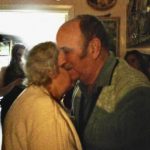
 “The Ultimate Blog Challenge,” which inspired me to write every day, something I have been doing for almost ten years now. So began a “career” of writing a blog every day. It was a way to step outside myself and my busy life and to hopefully a chance to write interesting stories for my readers. It’s strange where life takes you. The twists and turns that help you find yourself and your talents in ways you never expected. Twists and turns that change your life into something so different from what you thought it would be.
“The Ultimate Blog Challenge,” which inspired me to write every day, something I have been doing for almost ten years now. So began a “career” of writing a blog every day. It was a way to step outside myself and my busy life and to hopefully a chance to write interesting stories for my readers. It’s strange where life takes you. The twists and turns that help you find yourself and your talents in ways you never expected. Twists and turns that change your life into something so different from what you thought it would be.

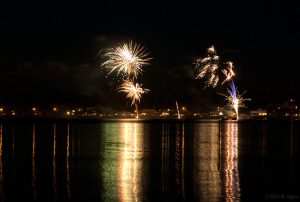 For many years, my husband, Bob Schulenberg and I have gone to the Black Hills to celebrate Independence Day. It has been our tradition for about 30 years. This year, things got changed up a bit. Our daughter, Amy Royce and her husband Travis invited us to come to Washington to spend the holiday with them. We will be watching the fireworks display at Semiahmoo Bay on the 4th. Bob and I went there a couple of years ago when we spent Thanksgiving with Amy’s family. The bay is beautiful, and I’m sure it will be even more fun in the summertime warmth…although it wasn’t very cold in November. We have never seen fireworks set off over water, so that will definitely be something new, and something about which we are very excited.
For many years, my husband, Bob Schulenberg and I have gone to the Black Hills to celebrate Independence Day. It has been our tradition for about 30 years. This year, things got changed up a bit. Our daughter, Amy Royce and her husband Travis invited us to come to Washington to spend the holiday with them. We will be watching the fireworks display at Semiahmoo Bay on the 4th. Bob and I went there a couple of years ago when we spent Thanksgiving with Amy’s family. The bay is beautiful, and I’m sure it will be even more fun in the summertime warmth…although it wasn’t very cold in November. We have never seen fireworks set off over water, so that will definitely be something new, and something about which we are very excited.
Celebrating our nation’s independence has always been a favorite holiday for Bob and me. We love everything about it. The fireworks take my thoughts back to history lessons, of the Revolutionary War. The rockets shot at ships, and the fighting that took place because we were a nation ready to be our own country. The fighting was sometimes brutal, but it was necessary. The patriots willingly gave their lives for the cause of independence. The fighting took place on land and water, and yet we have never seen fireworks over the water…until now. In my mind, I can see the ships from the Revolutionary War out in the bay. I can imagine the fireworks are the rockets, and the war is real. Nevertheless, I am glad that it isn’t really real, because I would not want our soldiers to have to relive that, but I can feel like a mouse in the corner, watching as history unfolds in front of my eyes…at least I can imagine it.
Of course, the fireworks aren’t the real thing, but rather just reminder of what our nation and the soldiers who fought for our independence, went through. My imagination of happened is just that…a figment of my imagination, because those events are long in the past. Still, I don’t believe that we should ever forget the lessons of war. There is always a reason we go to war…a wrong that must be made right, tyranny that must be stopped, killing that must be squashed, and slaves who must be made free. Good nations don’t go to war for 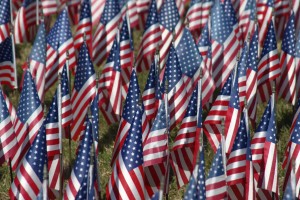
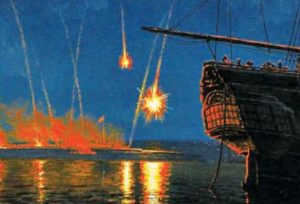 evil purposes. I believe that the most important lesson to be taken away from any war, is that we must never trust our enemies, and even more importantly, we must never allow the enemy to infiltrate our nation and our government. Happy Independence Day to our great nation…the United States of America. Forever may our flag fly and forever may our nation stand.
evil purposes. I believe that the most important lesson to be taken away from any war, is that we must never trust our enemies, and even more importantly, we must never allow the enemy to infiltrate our nation and our government. Happy Independence Day to our great nation…the United States of America. Forever may our flag fly and forever may our nation stand.
 My grand nephew, Lucas Iverson is a sweet boy who is eager to learn new things. Lucas has Down Syndrome, but that has not slowed him down. Lucas is attending summer school, which will help his to stay on track with his studies. He is going to be in second grade next year and is doing very well in school. Because of Lucas learning disabilities, the school is working with innovative new ways of teaching him, and he is doing very well. They are using a picture communication book to teach him. Lucas uses Velcro stickers to ask for what he wants or to answer questions. The idea is that if Lucas needs to go to the restroom, there is a picture of a toilet. If he is thirsty, there is a picture of a glass of water. There are pictures of food, a bed, a car, a park…you get the picture. The best part is that it’s working for Lucas, and he is excelling at it.
My grand nephew, Lucas Iverson is a sweet boy who is eager to learn new things. Lucas has Down Syndrome, but that has not slowed him down. Lucas is attending summer school, which will help his to stay on track with his studies. He is going to be in second grade next year and is doing very well in school. Because of Lucas learning disabilities, the school is working with innovative new ways of teaching him, and he is doing very well. They are using a picture communication book to teach him. Lucas uses Velcro stickers to ask for what he wants or to answer questions. The idea is that if Lucas needs to go to the restroom, there is a picture of a toilet. If he is thirsty, there is a picture of a glass of water. There are pictures of food, a bed, a car, a park…you get the picture. The best part is that it’s working for Lucas, and he is excelling at it.
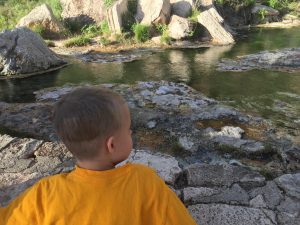
One of the things that is helpful to Lucas is to have a schedule that is followed religiously. Everyday schedule changes are difficult for him to deal with, so keeping him on a strict schedule helps him to stay on task. His learning works best in an environment of stability and organization, and since he is doing so well in school, his parents, Cassie and Chris Iverson don’t want anything to get in the way of that. Lucas has been an inspiration to them…and to many of the rest of us in the family too.
Of course, no kid wants to do nothing but study all summer, and Lucas is no exception. So, the family has been doing lots of fishing this summer. And they are planning to go to the fair to celebrate Lucas’ birthday. They have been doing lots of gardening too, and Lucas loves to play outside in his new backyard with his little sister, Zoey, and helping his mom with new  photography ideas, like the lens ball. But one of the biggest things that is going on with Lucas is that he is growing like a weed. He weighs 40 pounds and he is 40 inches tall. While that isn’t average for an 8 year old boy, it is pretty good for Lucas, who has struggled with his digestive system, and has been through multiple surgeries. Lucas is a strong, brave boy, who pushes through every time, and always with a smile on his face. The very best news is that he is doing so well in his health right now, that he doesn’t have to go back to the doctors for 6 months. Now that is something to celebrate. Today is Lucas 8th birthday. Happy birthday Lucas!! Have a great day!! We love you!!
photography ideas, like the lens ball. But one of the biggest things that is going on with Lucas is that he is growing like a weed. He weighs 40 pounds and he is 40 inches tall. While that isn’t average for an 8 year old boy, it is pretty good for Lucas, who has struggled with his digestive system, and has been through multiple surgeries. Lucas is a strong, brave boy, who pushes through every time, and always with a smile on his face. The very best news is that he is doing so well in his health right now, that he doesn’t have to go back to the doctors for 6 months. Now that is something to celebrate. Today is Lucas 8th birthday. Happy birthday Lucas!! Have a great day!! We love you!!

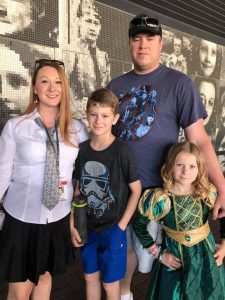 My niece, Chelsea Hadlock, wife of my nephew, Ryan Hadlock, has spent a number of years being a great stay-at-home mom, raising their kids, Ethan and Aurora. She is a great mom and both of their kids are just as sweet as they can be and very well mannered. Chelsea and Ryan have done a wonderful job with the kids. Chelsea and the kids are hanging out this summer, gardening, going to the summer movies and making a couple of trips to Loveland to see their grandma, Debbie Moss. Chelsea and Ryan get together with the Hadlock family for barbecues and dinners at each other’s houses. It’s a great part of summer. Chelsea makes an excellent potato salad and a super yummy dip which the family always ask her to make. I know from experience Chelsea is an excellent cook, and we have all been treated to her cooking and believe me, it is excellent.
My niece, Chelsea Hadlock, wife of my nephew, Ryan Hadlock, has spent a number of years being a great stay-at-home mom, raising their kids, Ethan and Aurora. She is a great mom and both of their kids are just as sweet as they can be and very well mannered. Chelsea and Ryan have done a wonderful job with the kids. Chelsea and the kids are hanging out this summer, gardening, going to the summer movies and making a couple of trips to Loveland to see their grandma, Debbie Moss. Chelsea and Ryan get together with the Hadlock family for barbecues and dinners at each other’s houses. It’s a great part of summer. Chelsea makes an excellent potato salad and a super yummy dip which the family always ask her to make. I know from experience Chelsea is an excellent cook, and we have all been treated to her cooking and believe me, it is excellent.
Now, Chelsea has decided to get her real estate license, so she is studying very hard for her test. She will make an excellent realtor. My sister, Allyn Hadlock thinks real estate may just end up being Chelsea’s niche! I can see that. Chelsea is a very social person, and she knows houses and decorating too. Chelsea and Ryan are going to buy my sister and brother-in-law, Chris Hadlock’s house when they move to their new home. Ryan and Chelsea are hoping she will be able to be the realtor when they sell their own house. This is going to be a really good thing for their family. Real estate is a great career move.
Chelsea is such an asset to our family. In the 11 years since Chelsea joined our family, she has shown a 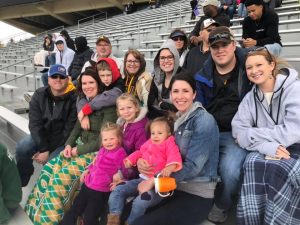
 willingness to help out wherever she’s needed and she is a much loved member of the family. Chelsea has a beautiful smile, and always makes those around her feel good. She has always want to be a mom, and have a family, and so her own family has been a dream come true. For my sister and brother-in-law, they couldn’t have asked for a better person to be their only daughter-in-law. We all love Chelsea, and we couldn’t be happier to have her in our family. Today is Chelsea’s birthday. Happy birthday Chelsea!! Have a great day!! We love you!!
willingness to help out wherever she’s needed and she is a much loved member of the family. Chelsea has a beautiful smile, and always makes those around her feel good. She has always want to be a mom, and have a family, and so her own family has been a dream come true. For my sister and brother-in-law, they couldn’t have asked for a better person to be their only daughter-in-law. We all love Chelsea, and we couldn’t be happier to have her in our family. Today is Chelsea’s birthday. Happy birthday Chelsea!! Have a great day!! We love you!!

